
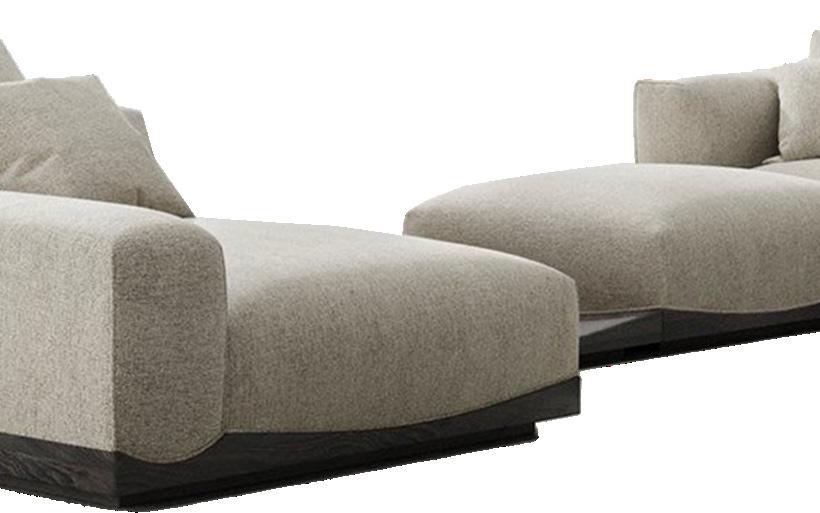




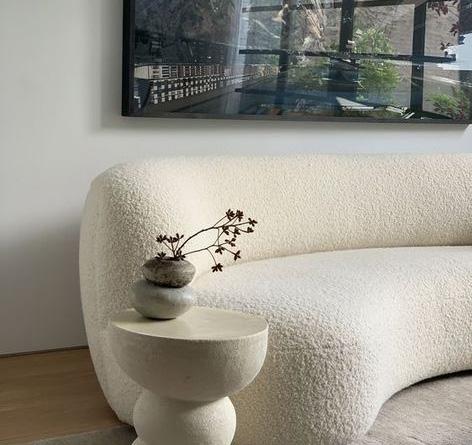















Each room of the house has a protagonist furniture. The sofa undoubtedly represents the protagonist of the living room, a crucial element for the success of the furnishing of this part of the house that is very lived in and convivial but, sometimes, also intimate and relaxing.
In an interior design project, keeping an overall vision in mind is essential. This means not buying quickly and exclusively on the basis of what wins us over at first glance. A piece of furniture that we really like aesthetically may not fit well in the environment we are creating. So it’s always better to start from a coherent base and enrich the interior, with attention and taste, through the introduction of some contrasting notes such as a brightly colored sofa in a neutral interior, an antique sofa in a modern context or, vice versa, a modern sofa in an ancient context.
Evaluating the proportions of the sofa is essential to be able to choose the most suitable model for the living room, which is neither too small compared to the environment in which it will be placed, nor on the contrary too large. To calculate the number of seats on the sofa you are going to purchase, it should be noted that each person occupies an average space of about 50 cm.
The sofa, also due to its size, is the protagonist of a living area. To enhance this piece of furniture it is essential to decorate the space around it with the right accessories. First of all, the coffee table: it must be functional, practical but decorative at the same time. Rectangular, square or round? It all depends on the style and shape of the sofa and room. Also pay attention to the materials that must be in accordance with the style of the living room and therefore of the sofa.
The DANDY collection is made up of modules that can also be used as puffs, backrests and allows multiple compositions to satisfy the most diverse space and customization needs.




The sofa as we understand it today, or a seat designed to accommodate two or more people at the same time, is a relatively recent piece of furniture in the West, as is the living room, an achievement that dates back to the aristocratic residences of the eighteenth century. Perhaps the idea of being able to sit next to each other was not very welcome to our ancestors, given that at the time the sofa was a rare element, while armchairs of every shape and style abound: European individualists, however, were fascinated by administrative offices of the Ottoman Turks, called dīwān, where officials worked side by side, seated on wooden benches covered with cushions and carpets. This could be the origin of the term sofa, even if the French, who imported the idea of sitting in company into their homeland, used different terms to describe the new furniture, and invented seats of all kinds, some of which are decidedly bizarre, such as the “causeuses” (from the French, chatty), two-seater sofas for intimate conversations, and the variants “Marquise”, “Tête à tête” (two or three-seater sofas formed by crossed seats) and “Indi-
The first sofas appear at the courts of Louis XIII and Louis XIV, even ifthe period of great diffusion on a European scale is that which coincides with the neoclassical style or Louis XVI (read about the Louis XIII style and the Louis XIV style). Since then the sofa has been one of the most important furnishings in the home, a symbol of social status, like the Chesterfield, a true icon of the Victorian period, or the object of daring experimentation at the beginning of the 20th century, thanks to the advent of new materials and of serial production. Since the 1960s, Italian design and industry have conquered the world, creating sofas with timeless lines, so much so that even today they are among the best sellers ever, such as the Charles sofa, dedicated to Charles Eames, produced by B&B in the late 90s. After all, many design pieces from the past are experiencing a remarkable revival, such as the Strips by Cini Boeri or the Maralunga by Vico Magistretti. Then came the time of Chersterfield, at the end of the
18th century, as well as the Empire style, with a combination of classical and medieval motifs, or the sinuous lines of Art Nouveau, up to the Postmodern with the Midcentury and other artistic movements that influenced even the furniture and brought the design of the sofa to a minimal concept of shapes and lines. I conclude the post with a duti iful and welcome mention of Cassina, a company founded in 1927 by two brothers from Brianza, and which still today produces the furnishings that have gone down in history, perpetuating the tradition of the best made in Italy. As the cover image, I chose the 552 Floe insel sofa designed by Patricia Urquiola for the 2017 Cassina collection, inspired by the irregular and asymmetrical shapes of icebergs, because it has a very original line that reminds me of the Star Trek spaceship furnishings... Today the production of sofas still reflects many of these styles in a contemporary reinterpretation. But the most significant current influence comes from the Far East and is part of a brand new concept of sofas and, in general, a new lifestyle at home.
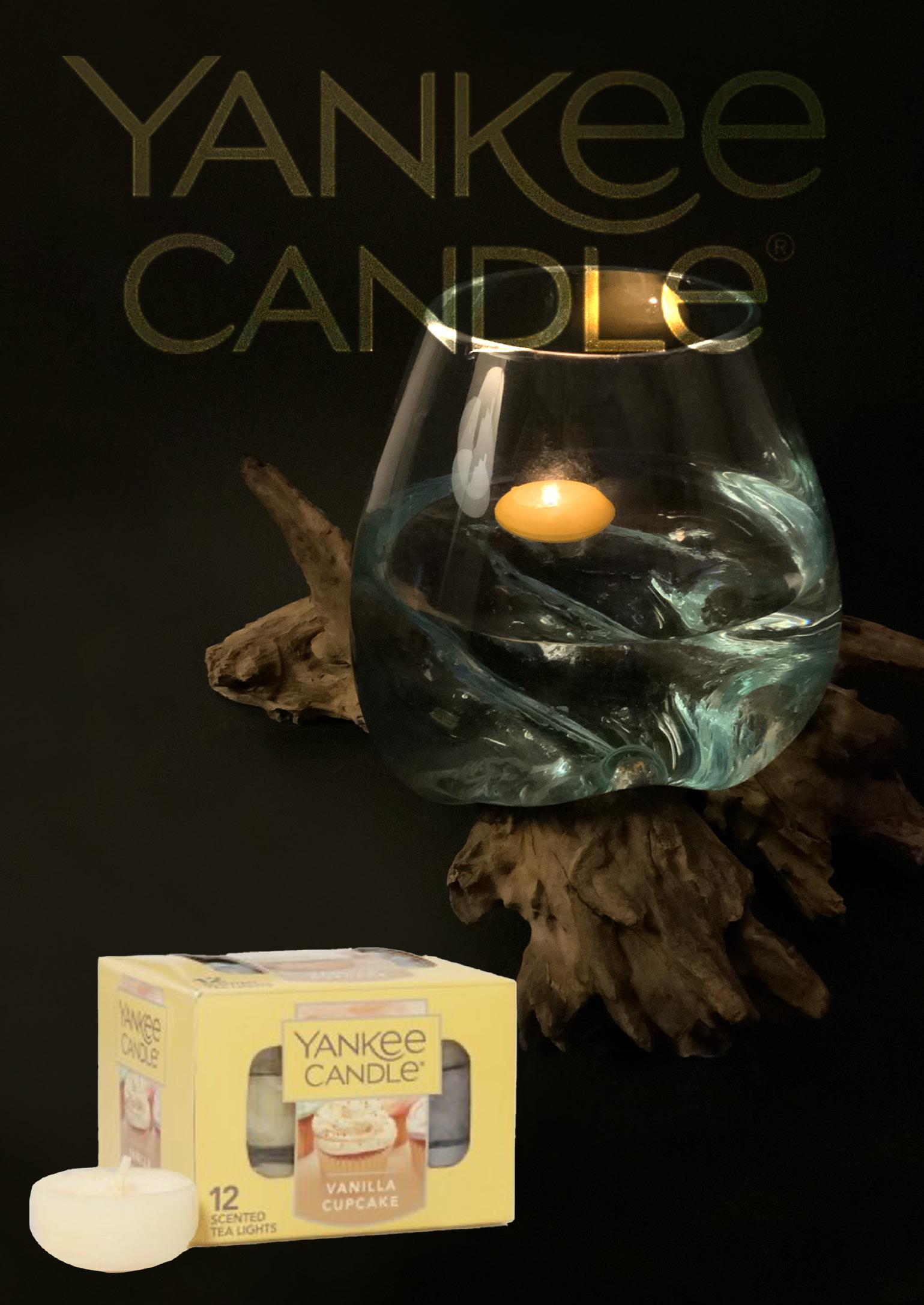



The two-sea - ter sofa is very often present in the living room of Italian homes, sometimes together with a larger sofa or placed side by side with armchairs, in order to have additional seats. Thanks to its small size, the two-seater sofa allows interior decorators and designers to indulge themselves with shapes, colours, coverings, leathers, fabrics, structures and padding. The strong point of the 2-seater sofa is certainly its small size and small size. This feature allows it to be laced in different rooms of the house, not only the living room but also

the kitchen or hall, bedroom or guest room, perhaps in the sofa bed version. You can find comfortable models with a seat that is not too bulky and comfortable to sit on, but design fashion has recently pushed for the enlargement of the seat, which allows you to lie down even on a 2-seater sofa. Usually this kind of sofa does not exceed 2 meters in length.
 Charlotte Perrian
Charlotte Perrian
Cassina, 1973 M a r i o B e l l i n i , L e B a mbole, B&B Italia, 1970 L e C o r b u s i e r, P i e r r e





The 3-seater sofa is widespread in living rooms and in the rooms of larger and more spacious houses. Where the surfaces allow it, it is accompanied by armchairs or 2-seater sofas. The strong point of the 3-seater sofa is certainly the comfort and width of the seat.
The 3seater versions with chaise longue and the versions with sofa bed are increasingly popular. The 3-seater sofa usually has a length measurement between 2 and 3 meters.
Bubble a three seater sofa, expresses the balance between innovation, function and emotion. Inspired by natural and mineral shapes and completely handmade, its conception required the development of specific stretch fabrics that perfectly match its rounded shapes. With its unique style, is an iconic model of the Roche Bobois collections Comfort and fantasy for this armchair that recalls sea sponges, upholstered in exclusive Techno 4D fabric, which rotates on itself, as if moved by sea currents. Swivel armchair, upholste-
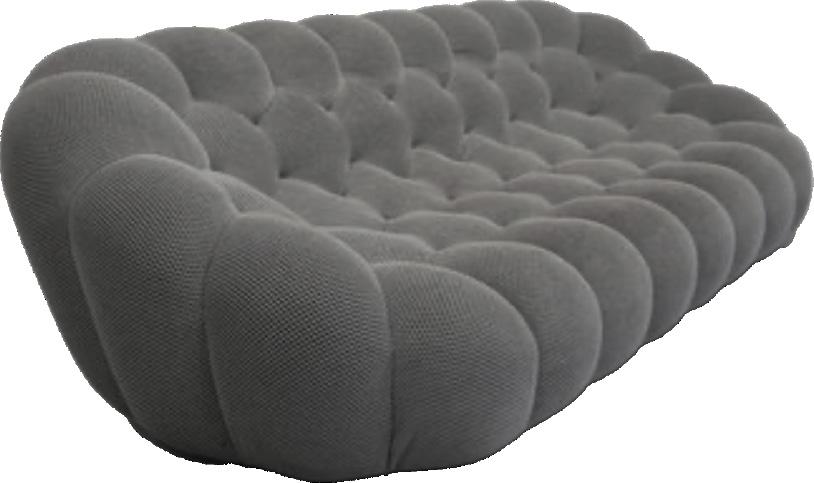

(designed by Sacha Lakic, produced by Roche Bobois, early 21st century)

red in Techno 4D fabric. Seat and back padded with dual density polyurethane foam. Structure in solid wood and plywood.
Swivel base in chromed metal with automatic return mechanism with position memory. € 4.500
 (designed by Massimo Iosa Ghini, produced by Moroso, 1990)
(designed by Massimo Iosa Ghini, produced by Moroso, 1990)
Newtone has rounded shape. The NewTone collection is made of non-deformable polyurethane foam in different densities and polyester fiber with a wooden structure. Seat in non-deformable



polyurethane foam in dif ferent densities and polye ster fibre. The optional back cushions are in goose down. The feet are in alu minum or turned beech. Newtone is not removable.

Chloe is characterized by a remarkable aesthetic balance and refined materials. Available in two, three-seater and chaise-longue versions, it has a wooden or metal base and an upholstered seat and back capable of elevating any environment. Soft curves prevail in every element of the Chloe sofa. Domkapa has a great passion for detailed stitching, which has several similari-
ties with the haute-couture philosophy centered on the value of “handmade”. Domkapa challenges his team to create the perfect everyday encounter between design and comfort in each piece of the brand’s collections. € 4,200
The characteristic of the corner sofa is that it has the classic L shape, and is therefore made up of two sections. The first section constitutes the main one of the sofa, usually containing 2 or 3 seats. This section has its armrest removed in order to build the corner. The second section is therefore arranged at a right angle and leaning against the first, allowing for more space to be obtained on the seat. Additional space can also be characterized by a place to stretch out called a “Chaise Longue” or sundial.
The latter can be positioned both to the right and to the left of the main section, thus making it possible to obtain different furnishing combinations by adapting to the space available and/or to the tastes of the decorator. The corner sofa is more suitable for large environments that can accommodate large corner sofas up to 6 or 7 seats, but today there are also models of corner sofas with a reduced number of seats (even 2 or 3) to be able to furnish rooms with style smaller.


Visiona is Olivier Mourgue’s most ‘fabulous yet most unknown’ complete interior design project. the most talented designers from around the world have collaborated to create entire futuristic displays aboard an swhip in Cologne, Germany.
During Visiona, Olivier Mourgue created an entire natural landscape with
rivers, carpets that resembled earth, grass, and other natural floor coverings, with modular movable rooms.
The Visiona of Olivier Mourgue was a Utopia where man and nature lived side by side in peace. Olivier Mourgue’s Visiona was one of the most memorable interior installations created for this project. An open, undivided living
area in which all family life takes place, a community environment that adapts to the transformations of the family (birth of children, leaving of children who have become adults) variability of space, natural freedom of movement, inclusion of the nature of environment, for example by means of a soft floor that recalls moss and earth



Colombo’s production is recognized by the world of design as visionary and innovative, thanks to the conception of modular and complex systems. Joe Colombo’s solution assumes that it can be transformed into a completely free plan. The user’s imagination is entrusted with the task of forming the different groups, but also that of choosing how to sit or lie down
The statuesque design of this collection represents dignity, calm and stability. Fixed lines create monumental shapes and give a feeling of serenity. Each piece in this collection has a sculptural feel and each angle reveals a different image. Structure in plywood and wood, padding in foam and latex of different densities. Feet in hidden polyurethane.



(designed by Mario Bellini, 1970)

Presented to the public in 1970, Camaleonda has gone through 5 decades of design history as the absolute protagonist. 90 x 90 cm module seat. The founding feature of Camaleonda is its almost infinite modularity. € 6.183,00 for set
(designed by Michel Ducaroy for Ligne Reset, 1974)
The iconic Togo sofa, has become a mid-century design classic. The piece features the pleated fabric design, which gives the chair its relaxed aesthetic. The set has reupholstered in a soft and supple brown leather. Made entirely of foam, with three different densities. € 14.571 price for set

(designed by Mimo Padova, 1970)
Very comfortable sofa made up of four modular elements of voluminous shape molded together by chromed metal clamps. The sofa is upholstered in a grey-green velvet fabric by Dedar®, even the foam has been redone following the original lines. It offers great comfort and is in very good condition. € 19.200 for set

(designed by Burkhardt Vogtherr for Rosenthal, 1970 - 1979) Four large elements and two small elements that can be inserted into compositions of divers A total weight of 77 kg. € 12.350 price for set

(designed by Giancarlo Piretti for Castelli, 1970 - 1979)
The Sistema 61 modular sofa is an original design object created by Giancarlo Piretti for Castelli, Italy, 1970s. Modular system of sofas called “Sistema 61” which consists of a surprising composition of four seats. A design icon not to be missed. Upholstery in gray fabric. € 9.090 price for set




Franco Audrito founded Studio65 in Turin in 1965 as an avant-garde experimentation collective that brought together a group of artists, painters, photographers, and aspiring filmmakers- all students of the Faculty of Architecture. In 1975 Franco Audrito and his partner Athena (Nanà) Sampaniotou, along with their Studio65 colleagues, began their adventures in the Middle East, leading the studio to win competitions and build structures in Saudi Arabia, Syria, Tunisia, Egypt, and then Russia, Indonesia, England, China and the UAE. Studio65 pursues projects of high quality on architectural, engineering, environmental aspects, achie -
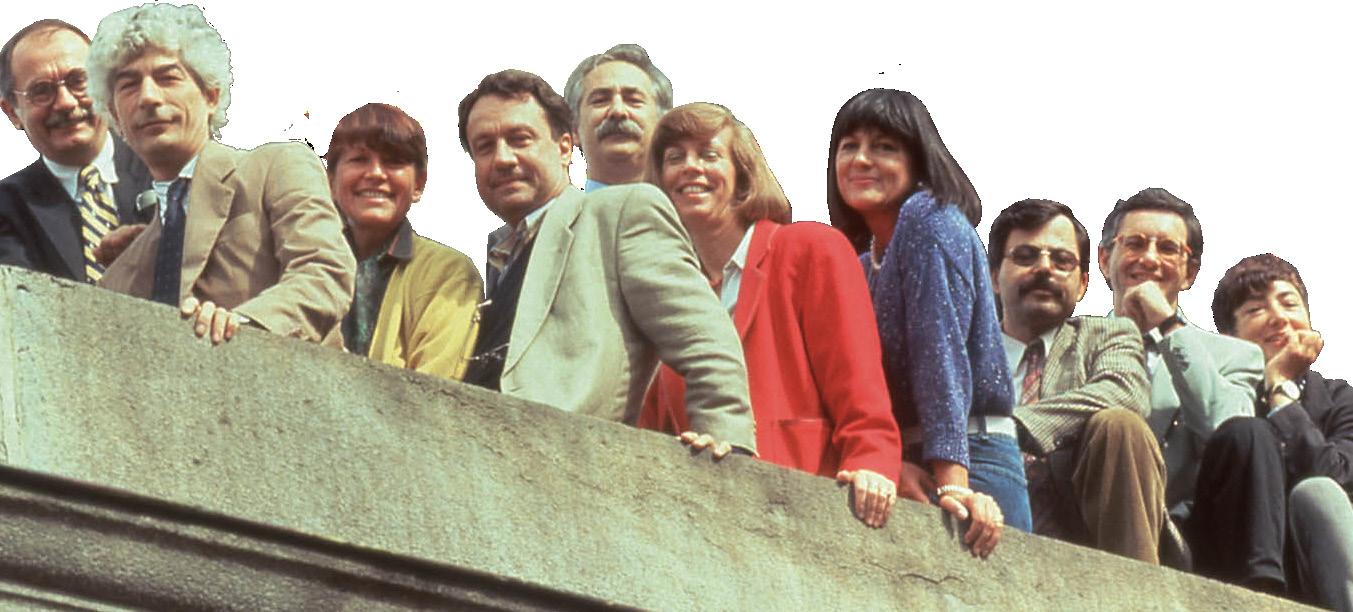
ving this aim through its close collaboration with the clients and the excellence of its team of architects and specialists: structural and infrastructural engineers, planners and environmental consultants, craftsman and model prototype, cost specialists and project management to create the project of high quality on drawings production, specifications, cost analysis, budget definition, time scheduling, 3D models and renders presentation for conceptual design and competitions. Studio65 offices are currently based in Turin, Italy and Riyadh, Saudi Arabia. Franco Audrito is also a famous international designer for fornitures and interiors. The most famous designed pieces are the
s“Bocca” sofa and the “Capitello” armchair and are permanent exhibition at the MOMA in New York, Milan Triennale museum, Beaubourg contemporary art museum in Paris, Louisiana contemporary art museum in Copenhagen and many others all around the world.



With ironic sensuality, Bocca sofa represents the symbol of a time in which appearance prevailed over quality of being. In the ’60s, the myth of stereotypical beauty pushed by the gossip and fashion magazines was forcefully affirmed, consolidating its perceived superiority over the quality of the human being and of thought. It is a phenomenon that has been intensifying over the past 45 years, turning the Bocca sofa into its eternal symbol and testament .The sofa is designed for the entrance of a wellness center in Milan, the Contourella (where we designed all the interiors), inspired by the famous Mae West With ironic sensuality, Bocca sofa represents the symbol of a time in which appearance prevailed over quality of being. In the ’60s, the myth of stereotypical beauty pushed by the gossip and fashion magazines was forcefully affirmed, consolidating its perceived superiority over the quality of the human being and of thought. It is a phenomenon that has been intensifying over the past 45 years, turning the Bocca sofa into its eternal symbol and testament. The Bocca sofa is designed for the entrance of a wellness center in Milan, the Contourella (where we designed all the interiors), inspired by the famous Mae West lips sofa by Salvador Dalì.

The Pratone designed in a studio in Turin, is made of polyurethane, a new material that came from America. The quality was and still is very appealing. This simple and versatile “birth” seemed as though it could compete with nature’s products and replace the natural landscape. These experiments carried out on this con- cept were behind the Pratone project, which challenged the naturalness of nature by toying with the formal reproduction of an ele-


ment, altering its normal dimensions. I believe that the great success of this object (which is present in at least ten American and European museums) stems from a certain perplexity in seeing the destruction of nature’s objectivity.A perplexity that can produce joy and pain, for example by opening up new horizons: the
story behind the gesture of “lying down in the grass!” Without using complex technologies, the Pratone causes us to reflect on the possibility in the future that some artificial creations might actually undermine the fascination with nature’s stability, the nature that we all want to defend today. If with our reckless ac- tions we were to kill nature, could we then re- build it artificially? A very dangerous thought, and the central theme, among others, of the 23rd Triennale di Milano. The Pratone takes us back to these thoughts.



 (designed by Ueli Berger, Eleonore Peduzzi-Riva, Heinz Ulrich, Klaus Vogt
(designed by Ueli Berger, Eleonore Peduzzi-Riva, Heinz Ulrich, Klaus Vogt

The DS-600 modular sofa has a structure in wood panels and polyurethane foam; Padding in SEDEX and wadding and upholstery in various types of leather or fabric. The DS-600 modular system has become one of the icons of the Swiss brand and has also earned a place in the Guinness Book of World Records for the configuration of the longest sofa in the world. It’s characterized by the particular shape of the individual elements that make up the seat - a play of concave and convex volumes - and by the possibility of creating infinite articulated and articulated compositions, with a serpentine, circular or semi-circular shape depending on the needs. Not a simple sofa, but a sculpture, perfect for decorating living
rooms and contract areas.
The longest DS-600 is currently located in the palace of the ruling family of a sultanate, where the legendary 406 upholstery elements in rainbow colors come together to create an endless circular or serpentine sofa.
The sculpture affectionately
called “Tatzelwurm” has also taken up residence in the living rooms of Tina Turner, Jerry Hall and Mick Jagger and has become the “star” of numerous Bond films - even New York’s legendary “Studio 54” adorned itself with the ‘elegant sofa. €45.091,00
for de Sede, 1972)Its structure consists of an assembly of 7 foam padded cushions of different widths and depths covered in leather; the whole is mounted on a rectangular base plywood structure. The DS-1025 sofa also called “Landscape Terrace” was designed by Ubald Klug in 1973 for the Swiss company de Sede. This model embodies the concept of the Swiss landscape like no other piece of furniture from this nation,
the designer in fact for the shape of the sofa was directly inspired by the mountainous reliefs of the Alps and the hilly terraces of the vineyards and this is represented on this sofa by means of multi-layered upholstery that invites a person to sit or lie down: the individual element is reminiscent of a terraced stepped slope with different widths and depths. The horizontal layering gives the impression of sitting on a topographi-


cal landscape model. Student of Willy Guhl, Ubald Klug proved unique in finding creative solutions, Paris has been his sphere of activity since 1966, while in the 1970s he collaborated with the leather furniture manufacturer de Sede. Ubald Klug (maverick when it comes to interior design) presented to the general manager at the time Urs Felber, an intriguing sketch of a sofa model based on the idea of a mound of sand deformed by the seat. Using the rectangular panels as a foundation, Klug proceeded to build a ta pestry landscape that was inviting for both sitting and lying down. He combined different elements into real living room landscapes. The sinuous and malleable upholstered volumes of the sofa had all the characteristics of a lifestyle then prevalent in the collective home of young people, with the exception of affordability. € 33.500 for set

 (designed by Fernando e Humberto Campana,
(designed by Fernando e Humberto Campana,

The studio of the Brazilian brothers and designers Fernando and Humberto Campana focuses on the human being and the highest desires of each of us in terms of comfort and relaxation and for this goal we work every day to ensure that Edra comfort has an extraordinary dimension of existence, to be declined as desired in a thousand different ways, but always at the highest levels. The two designers draw inspiration for the creation of this model from the cultural history of Brazil for the materials, colours, blends and the “creative chaos” found in their collections. Edra, one of the darling Italian companies of the contemporary avant-garde which launched the brothers’ international career in the early 1990s. It is from this collaboration and from this eclectic and powerful mix that the Boa sofa was born, which carries within itself a bit of
a large, soft woven nest. An invitation to explore the infinite positions while lying down among its cushions, it has no structure as it is made from 120 meters of thick tube, filled with elastic and transpiring polyurethane with a touch of down and covered with velvet that covers them. It is an elegant fabric that makes the sofa particularly bright and assembled like a large soft nest where you can rest. It is both a sofa and a landscape, described by the Campanas as “an invitation”.

Boa sofa is entirely handmade by four people who work on it for over a week. Only for the final plot two days of work are needed. 300cm x 160cm x 65cm €19,720.00 355cm x 190cm x 65cm €26,210.00.
produced by Edra, 1990)
This iconic Aster Papposus sofa was designed in 2006 by Fernando and Humberto Campana, better known as the Campana Brothers, and produced by Edra. It’s a sofa with multiple seats, composed of two similar and complementary volumes without a rigid structure of any kind, realised in polyurethane foam and down. By overlapping and twisting


them, these two modules form the seat, backrest and armrest of a comfortable sofa. The cover, conceived by Edra exclusively for this model, is realised in very thick velvet which makes it visibly bristly and soft at the same time. With its dynamic look and unusual appearance, this iconic sofa is a true
conversation piece. It’s an impressive collectors item that offers up to eight comfortable seats. Since no internal structure is present, this sofa offers very relaxed positions. This piece features padding in a mixture of various density polyurethane foam and feathers, and has a technically removable cover. In 1983 Fernando and Humberto Campana began working together in Sao Paulo, where they still live and work. Their breakthrough as designers was the development of the Favela Chair in 1991, which was made from scraps of wood found in a São Paulo slum.The Campana Brothers became the first Brazilian artists to exhibit their work at The Museum of Modern Art (MoMA) in New York. Their breakout design of the Vermelha chair is still their bestseller. €40,972.16
(designed by Cappellini)




Big Sofa, covered in polished chromed or blacklacquered steel, is suitable for large residences or the lounges of accommodation facilities and is defined by a powerful recognizable design.
(designed by Nina Edwards Anker)
Upholstered sectional in polyurethane foam. Structure in solid wood. Custom sizes and configurations. Dune is a system of upholstered elements with a soft and full look.
(designed by Maarten De Ceulaer)
The pieces might be the result of a mutation in cells, or the result of a chemical or nuclear reaction. Perhaps it’s a virus or bacteria that has grown dramatically out of scale. De Ceulaer’s work is also on show at the Triennale di Milano and as part of IN Residence at Ventura Lambrate.

The inventor of the sofa bed is Bernard Casto, an Italian genius who, after immigrated to the United States of America in 1919, began to build pull-out sofa beds while maintaining the elegance and style of a fixed sofa.
The turning point that determined the inventor’s success occurred thanks to an advertisement whose main advertising message was to underline the opening system not different from that of today’s sofa beds.
Nowadays the innovations concerning sofa beds are characterized by a high rate of technology as smart solutions have become very many. The modern sofa bed is designed in such a way that even those who have little space available, but don’t want to give up the comfort of a bed in any way, can take advantage of this solution. The sofa bed represents a revolution from a conceptual point of view, which leads to a review of the relationship with spaces, focusing on one’s own needs, especially that of practicality which most characterizes modern life. Indeed, it is a piece of furniture designed to adapt perfectly to the evolving needs of the inhabitants of the house. Whether it’s a studio flat that becomes a bedroom during the night or a living room that turns into a guest room, this model is one of the most versatile pieces of furniture ever.
(designed
by Osvaldo Borsani, produced by Tecno Italy, 1953)Beautiful, comfortable and absolutely new, it has a visible mechanism that allows different opening angles between the seat and the backrest, up to complete reversibility. It is inimitable in its functionality, extraordinarily harmonious in its shapes, perfect in domestic environments but also in waiting areas, lounge areas and private offices.
D70 is the original sofa with movable wings.The series of adjustable movements go from complete closure to total opening up to making it a bed. The structure is extremely comfortable for the adaptability of its soft parts to the person, thus becoming an iconic object in terms of aesthetics and irresistible in terms of comfort. The project stems from a specific request from a private client: on the one hand enjoying the view from the window and on the other lazing in front of the fireplace in the evening. Hence the “patented sofa bed” presented at the Single Furniture Exhibition at the X Triennale in 1954.
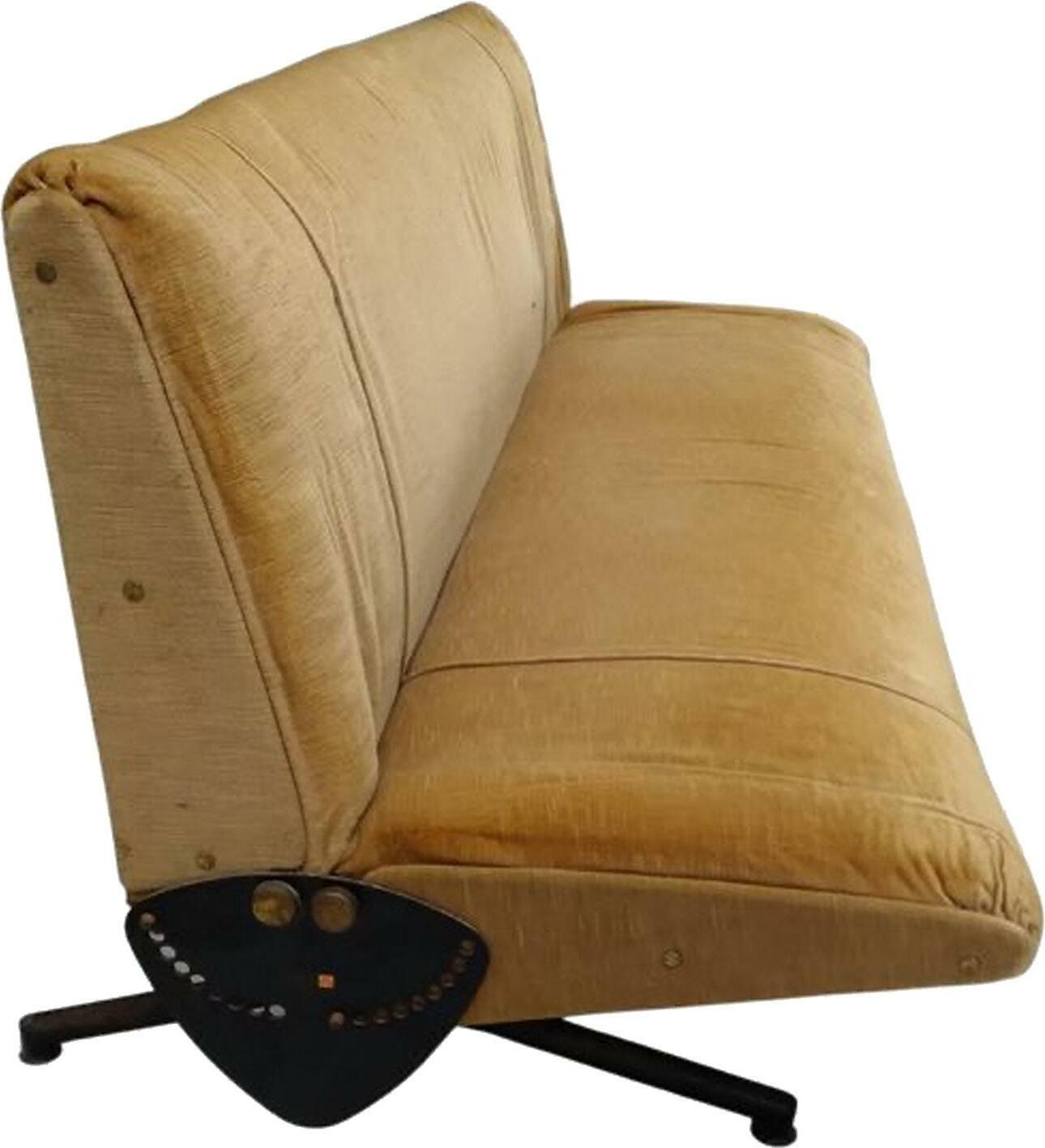

 (designed by Alessandro Becchi, produced by Giovannetti, 1970-1979)
(designed by Alessandro Becchi, produced by Giovannetti, 1970-1979)

Anfibio, a sofa bed, which has always been considered one of the most revolutionary and innovative products of Italian design. Since its first public appearances in the early 70s, it was selected and became part of the design collections of the largest museums in the world; first of all the MoMa in New-York, which bought it in 1972. Since then, 13 contemporary art museums have counted it among their pieces. Anfibio is a sofa bed, which has always been considered one of the most revolutionary and innovative products of Italian design. It was designed in 1971 by Alessandro Becchi for the Giovannetti company in Pistoia. At the time it had innovative features and original lines: rounded shapes,
soft, welcoming and protective.
Over the years, Giovannetti made it even more original and functional thanks to many technologically innovative aspects that have gradually been perfected over time.
The high-thickness polyurethane mattress and the removable leather cover.
The “transformation” from
sofa to bed happens very quickly and is almost a game especially if done in company: watch the video at the end of this article to see all the possible configurations.




